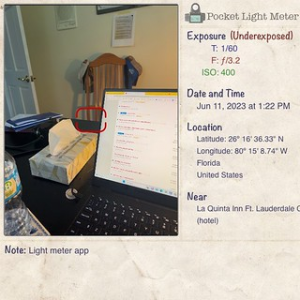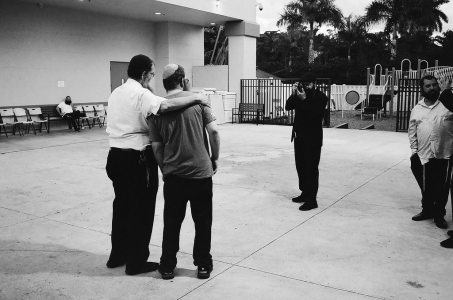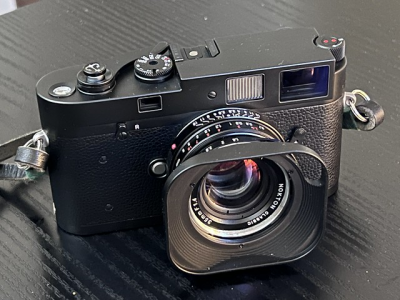kshapero
South Florida Man
I have an M-A, M3 and a Nikon F (no meter). Why I deem them so important? Because using them teaches how to setup your metering by feel (you will get better at this over time), It teaches you in the beginning to guess exposure but you will get better at this with time, too. I can look at the top of my camera before composing and set the aperture, Shutter speed and even the focus before I even compose. Then I bring the camera up to my eye to compose the shot. Mostly use a 35mm lens. A very pleasurable experience.
I do "cheat" sometimes if I really am clueless about an exposure, I will whip out my iPhone to use an app called light meter.

I do "cheat" sometimes if I really am clueless about an exposure, I will whip out my iPhone to use an app called light meter.

kshapero
South Florida Man
kshapero
South Florida Man
Retro-Grouch
Well-known
All of what you say is true. By the same token, having become proficient at these skills over the years, I also feel comfortable with automation. A quick glance at the camera's choices will either confirm my intuition or flag the need for an override. But sometimes I'm lazy. Sometimes there really isn't time to think. And sometimes (most often, lately) I'm shooting color transparency film; a meter is a must with that unforgiving stuff, particularly with medium format, and with its cost per frame. I like the fully manual, meterless experience, but I've also learned not to be too dogmatic about it, and most other things in photography as well.
kshapero
South Florida Man
Good pointsAll of what you say is true. By the same token, having become proficient at these skills over the years, I also feel comfortable with automation. A quick glance at the camera's choices will either confirm my intuition or flag the need for an override. But sometimes I'm lazy. Sometimes there really isn't time to think. And sometimes (most often, lately) I'm shooting color transparency film; a meter is a must with that unforgiving stuff, particularly with medium format, and with its cost per frame. I like the fully manual, meterless experience, but I've also learned not to be too dogmatic about it, and most other things in photography as well.
ptpdprinter
Mentor
There is nothing magic about a meterless camera. If you have a manual camera with a built-in meter, you can just take the battery out. I don’t know why you would want to do that, but it is an option available to you.
And why are you posting a photo of your Leica?
And why are you posting a photo of your Leica?
Last edited:
I carried my Weston Master with me for a long time after getting the M8.
But after a while of agreeing with the Weston, learned to trust it.
On the cameras with meters- best to check calibration from time to time. If they agree with me and the Weston, probably good. The latter- found in a box that had been stored in a Lab since WW-II, some 20 years ago.
But after a while of agreeing with the Weston, learned to trust it.
On the cameras with meters- best to check calibration from time to time. If they agree with me and the Weston, probably good. The latter- found in a box that had been stored in a Lab since WW-II, some 20 years ago.
JeffS7444
Well-known
I submit that the original Pentax Spotmatic was one of the finest teaching aids. Yes it had a TTL meter, but it worked with the lens stopped down to the taking aperture, so not only did I get a sense of how shutter speed and aperture could be used to control exposure, but it was also impossible not to see the effect that aperture had on depth of field.
Pál_K
Cameras. I has it.
As mentioned in another thread, at age 12 I started with a very simple inexpensive 8mm ciné camera. It had no meter, I had no meter, and I was using Kodachrome II at ASA 25. I could set apertures from f/22 to f/2.7, but that’s all the control I had, as the shutter speed was fixed at 1/30. Even so, that was enough - that’s how I learned exposure under various conditions. I got good at it.
On my first 35mm SLR, a Pentax SP500, the meter switch broke within the first week. Although I had it fixed, I just decided not to use the meter. So, for 15 years and thousands of photos, I never used a meter. I rarely got a truly bad exposure.
These days the only time I use a meter is when the camera relies entirely on battery power for operation.
On my first 35mm SLR, a Pentax SP500, the meter switch broke within the first week. Although I had it fixed, I just decided not to use the meter. So, for 15 years and thousands of photos, I never used a meter. I rarely got a truly bad exposure.
These days the only time I use a meter is when the camera relies entirely on battery power for operation.
Mackinaw
Think Different
I have an old Canon FP which is basically a FT-series camera without the meter. One of my favorite cameras. With a clear viewfinder, no need to worrying about matching needles, or looking at blinking lights, I just concentrate on composition, and take the picture. I do take along my old light meter just to give me an idea what kind of light I'm dealing with, but once that is done, it's picture time.
Jim B.
Jim B.
Keith
The best camera is one that still works!
One of my very early posts here on RFF was to share an exposure chart made to pocket size that was based on sunny sixteen. There is still one of those in my battered old Domke and at the time it was 'THE' most important part of my learning process. At some point in the near future I intend using it and a manual camera to remind myself how simple photography can be.
I have no issue using a meter to do my photography. However, I only use digital ...
ptpdprinter
Mentor
Touting that you shoot meterless seems like a perverse form of virtue signalling.
Canyongazer
Canyongazer
You have a supportive fellow by the name of Ralph Gibson in your corner.I have an M-A, M3 and a Nikon F (no meter). Why I deem them so important? Because using them teaches how to setup your metering by feel (you will get better at this over time), It teaches you in the beginning to guess exposure but you will get better at this with time, too. I can look at the top of my camera before composing and set the aperture, Shutter speed and even the focus before I even compose. Then I bring the camera up to my eye to compose the shot. Mostly use a 35mm lens. A very pleasurable experience.
I do "cheat" sometimes if I really am clueless about an exposure, I will whip out my iPhone to use an app called light meter.
View attachment 4822647
I was beyond surprised to discover RG frequently practiced setting aperture, SS and focus quickly with his M's while looking at a scene, not the camera. All by feel.
This was still true after decades of using pretty much nothing but Leica M cameras.
Canyongazer
Canyongazer
In Great Britain they probably use heavy overcast four. ;-)One of my very early posts here on RFF was to share an exposure chart made to pocket size that was based on sunny sixteen. T
Keith
The best camera is one that still works!
I found my original post from 2007 ... I love the history of this place and the fact that we still have it at our fingertips! 
An exposure chart for your pocket!
An exposure chart for your pocket!
kshapero
South Florida Man
I remember that. I printed out a version and taped it to my Nikon F.One of my very early posts here on RFF was to share an exposure chart made to pocket size that was based on sunny sixteen. There is still one of those in my battered old Domke and at the time it was 'THE' most important part of my learning process. At some point in the near future I intend using it and a manual camera to remind myself how simple photography can be.
Pál_K
Cameras. I has it.
It can seem that way, I agree. I think with many people though, they grew up using simple meterless cameras and acquired the skill of learning exposure settings for various conditions. It also helped having the latitude film offers regarding exposure. Therefore, they are far more comfortable and confident using a meterless camera or just not using the meter.Touting that you shoot meterless seems like a perverse form of virtue signalling.
But I’ll happily use the meter in my electronic cameras; some of the meter displays are quite nice.
What may have prompted this thread (and I could be totally wrong and presumptuous), is that some newer photographers think they absolutely must meter everything every single time otherwise their photo will be hopeless.
dave lackey
Mentor
I still have one of your charts in each camera bag AND on my iPhone!!!😂😂😂I found my original post from 2007 ... I love the history of this place and the fact that we still have it at our fingertips!
An exposure chart for your pocket!
Keith
The best camera is one that still works!
I still have one of your charts in each camera bag AND on my iPhone!!!😂😂😂
That pleases me immensely Dave!
Share:
-
This site uses cookies to help personalise content, tailor your experience and to keep you logged in if you register.
By continuing to use this site, you are consenting to our use of cookies.



